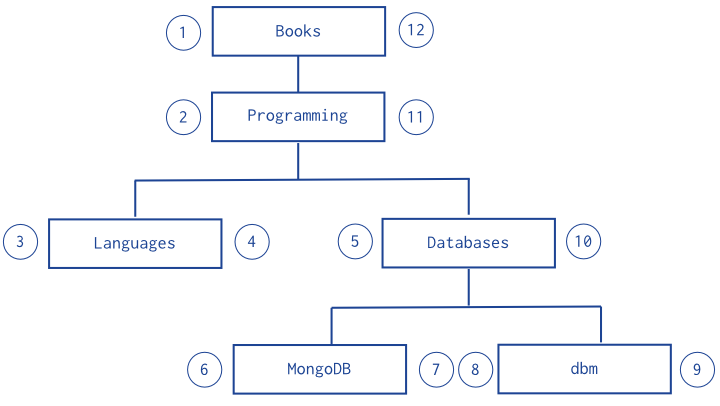- Data Models >
- Data Model Examples and Patterns >
- Model Tree Structures >
- Model Tree Structures with Nested Sets
Model Tree Structures with Nested Sets¶
Overview¶
Data in MongoDB has a flexible schema. Collections do not enforce document structure. Decisions that affect how you model data can affect application performance and database capacity. See Data Modeling Concepts for a full high level overview of data modeling in MongoDB.
This document describes a data model that describes a tree like structure that optimizes discovering subtrees at the expense of tree mutability.
Pattern¶
The Nested Sets pattern identifies each node in the tree as stops in a round-trip traversal of the tree. The application visits each node in the tree twice; first during the initial trip, and second during the return trip. The Nested Sets pattern stores each tree node in a document; in addition to the tree node, document stores the id of node’s parent, the node’s initial stop in the left field, and its return stop in the right field.
Consider the following hierarchy of categories:

The following example models the tree using Nested Sets:
db.categories.insert( { _id: "Books", parent: 0, left: 1, right: 12 } )
db.categories.insert( { _id: "Programming", parent: "Books", left: 2, right: 11 } )
db.categories.insert( { _id: "Languages", parent: "Programming", left: 3, right: 4 } )
db.categories.insert( { _id: "Databases", parent: "Programming", left: 5, right: 10 } )
db.categories.insert( { _id: "MongoDB", parent: "Databases", left: 6, right: 7 } )
db.categories.insert( { _id: "dbm", parent: "Databases", left: 8, right: 9 } )
You can query to retrieve the descendants of a node:
var databaseCategory = db.categories.findOne( { _id: "Databases" } );
db.categories.find( { left: { $gt: databaseCategory.left }, right: { $lt: databaseCategory.right } } );
The Nested Sets pattern provides a fast and efficient solution for finding subtrees but is inefficient for modifying the tree structure. As such, this pattern is best for static trees that do not change.
Thank you for your feedback!
We're sorry! You can Report a Problem to help us improve this page.
